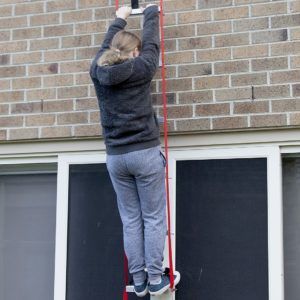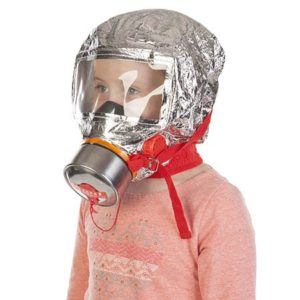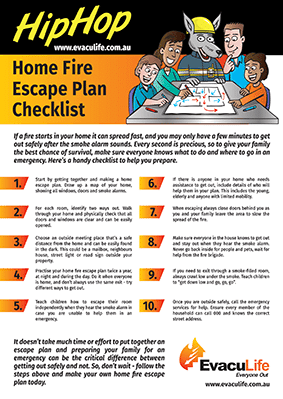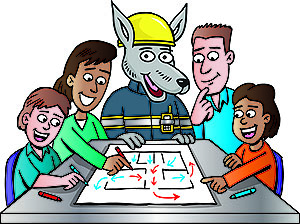
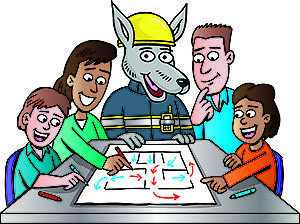 If a fire starts in your home it can spread rapidly, which is why the warning from your smoke alarm is critical to your survival. However, once a smoke alarm sounds you may only have one or two minutes to get out safely, so having an effective fire escape plan is also a must.
If a fire starts in your home it can spread rapidly, which is why the warning from your smoke alarm is critical to your survival. However, once a smoke alarm sounds you may only have one or two minutes to get out safely, so having an effective fire escape plan is also a must.
Making a plan and ensuring your home is well prepared for a house fire doesn’t take much time or effort, and it can be the difference between life and death. To help you put your plan together, here are 7 simple steps to creating an effective home fire escape plan to keep you and your family safe.
Install and Maintain Working Smoke Alarms

Australian laws require all homes to install smoke alarms. As a minimum, there must be one fitted outside sleeping areas, with at least one on each floor of the property. For the best protection, they should also be installed inside all bedrooms, especially if the door is kept closed during sleep.
For smoke alarms to save lives they need to be working – so be sure to test them every month. Replace regular batteries yearly, and if your alarm is older than 10 years, replace it altogether. Choose a photoelectric model with long-life lithium batteries, or upgrade to hard-wired smoke alarms if possible.
Draw Up Your Fire Escape Plan
Get everyone together and draw up a plan of your house, including all the exits and smoke alarms. Putting it on paper is essential if you have children, so they can easily refer back to it and be confident they’ll know what to do. Locate two ways out of every room using either windows or doors, mark it on the plan, and go into each room to visualise it so everyone is clear.
You should also take the opportunity to talk about some general fire safety tips that can help during an escape. This includes closing doors behind you to slow the spread of the fire and getting down low to crawl under smoke.
Check and Clear Escape Routes
It’s important to physically walk through your home and check that all exits are clear, and that windows and doors can be opened easily. If security bars are fitted to windows, make sure they have emergency release devices inside. If your home is multi-storey, emergency escape ladders can enable a safe escape. Keep ladders stored within easy access of the window and make sure everyone in the house knows how to use them.
Choose a Safe Meeting Place
Having a designated meeting place once you’ve escaped is essential. Pick somewhere that is a safe distance from your home, is easy to remember and can be located without too much trouble in the dark. This could be the mailbox, neighbours house or a street light or road sign outside your property. Mark it on your fire escape plan and make sure everyone knows exactly where it is so there is no confusion.
Contacting Emergency Services
Help all members of the family memorise 000, so that everyone can confidently phone emergency services if required. If you have young children, displaying the number on the fridge or notice board where they can visually see it can really help. Also, make sure everyone knows the house address, and that your street number is clearly identifiable from the road, either displayed on the mailbox or painted on the gutter.
Help Everyone Get Out Safe
If members of your household are young, elderly or have limited mobility, be sure to include specific steps in your plan to help them escape in an emergency. It’s a good idea to assign someone to assist them, plus a backup in case the designated person is not home when the fire starts.
Practise and Keep it Fresh in Mind
Once you’ve put your plan together, don’t file it away and forget about it. Keep it somewhere accessible, or even better, in view on a memo board or the inside of the pantry door. Then, make sure you practise your escape plan and discuss it with everyone who lives in the house at least twice a year.
It’s also helpful to hold a drill at night, and to use the opportunity to find out who wakes up to the smoke alarm and who doesn’t. You can then assign someone to wake up anyone who sleeps through the alarm to be sure everyone gets the warning they need to get out safely.
Bottom Line on Making an Effective Fire Escape Plan
Smoke alarms are an important first step in fire safety, but when you back them up with a clear and well-rehearsed fire escape plan, you give your family the best chance of escape.
Keeping your plan fresh in the minds of everyone in the house, especially children, can be the difference between panic and chaos and calm and confident if an emergency does happen.
Download or Fire Escape Plan Checklist
Download or Fire Escape Plan Checklist here

